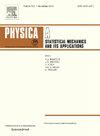地震统计模型:贝叶斯分析
IF 3.1
3区 物理与天体物理
Q2 PHYSICS, MULTIDISCIPLINARY
Physica A: Statistical Mechanics and its Applications
Pub Date : 2025-06-02
DOI:10.1016/j.physa.2025.130678
引用次数: 0
摘要
古腾堡-里希特(GR)关系是一种指数律,广泛用于描述地震的统计震级分布。利用统计物理方法,我们建立了基于Tsallis q-和Kaniadakis κ-熵的稳健模型,旨在捕捉不规则碎片占据两个具有不规则表面的构造板块之间空间的影响。所提出的模型分别称为q-GR和κ-GR定律。使用贝叶斯统计分析,我们检查了2000年至2023年间沿着圣安德烈亚斯断层记录的超过45万次地震事件的大型数据集。结果表明,q-GR和κ-GR模型优于经典GR定律。结果表明,κ- gr模型具有特别强的经验支持,当κ≈1时表现最佳。本文章由计算机程序翻译,如有差异,请以英文原文为准。
Statistical models for earthquakes: A Bayesian analysis
The Gutenberg–Richter (GR) relation is an exponential law widely used for describing earthquakes’ statistical magnitude distributions. Using statistical physics approaches, we present robust models based on the Tsallis - and Kaniadakis -entropies, aiming to capture the influence of irregular fragments occupying space between two tectonic plates with irregular surfaces. The proposed models are called -GR and -GR laws, respectively. Using Bayesian statistical analysis, we examined a large dataset of over 450,000 seismic events recorded along the San Andreas Fault between 2000 and 2023. Our findings reveal that the -GR and -GR models outperform the classical GR law. The results show the -GR model exhibits particularly strong empirical support, with optimal performance occurring when .
求助全文
通过发布文献求助,成功后即可免费获取论文全文。
去求助
来源期刊
CiteScore
7.20
自引率
9.10%
发文量
852
审稿时长
6.6 months
期刊介绍:
Physica A: Statistical Mechanics and its Applications
Recognized by the European Physical Society
Physica A publishes research in the field of statistical mechanics and its applications.
Statistical mechanics sets out to explain the behaviour of macroscopic systems by studying the statistical properties of their microscopic constituents.
Applications of the techniques of statistical mechanics are widespread, and include: applications to physical systems such as solids, liquids and gases; applications to chemical and biological systems (colloids, interfaces, complex fluids, polymers and biopolymers, cell physics); and other interdisciplinary applications to for instance biological, economical and sociological systems.

 求助内容:
求助内容: 应助结果提醒方式:
应助结果提醒方式:


